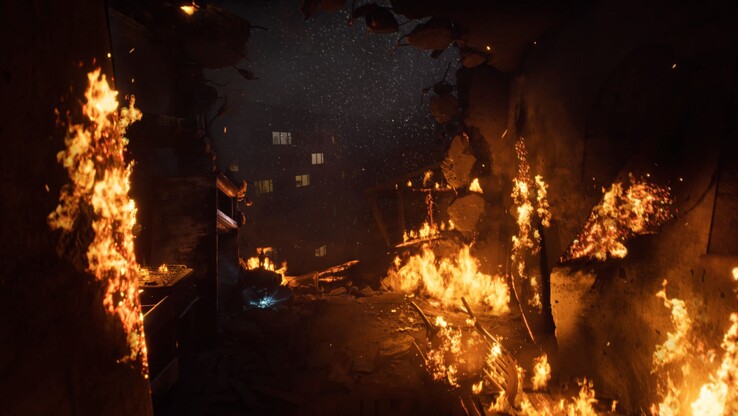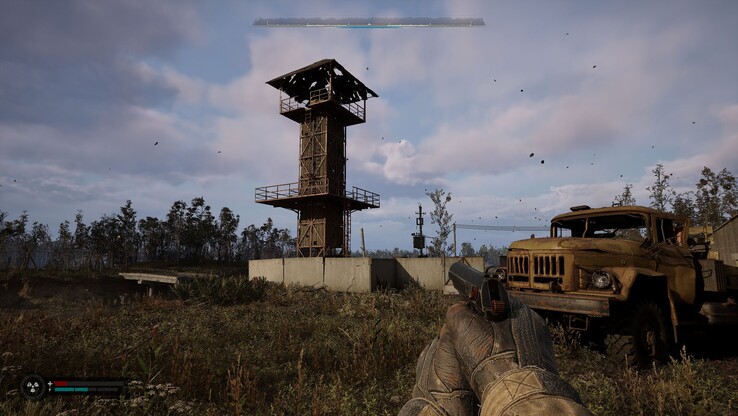
S.T.A.L.K.E.R. 2 benchmark test: Significant potential, but performance challenges remain
Allure of the unknown.
Despite its unfinished state, Stalker 2 has received overwhelmingly positive reviews. We have closely examined the game and the GPU requirements - especially with popular mid-range models such as the GeForce RTX 3060 and RTX 4060. Are these box office hits enough for a smooth gaming experience?Florian Glaser, 👁 Florian Glaser, ✓ Anton Avdyushkin (translated by DeepL / Ninh Duy) Published 🇩🇪 🇫🇷 ...
Verdict - Stalker 2 still immature and experiences FPS drops
Stalker 2 is an interesting and extremely atmospheric first-person shooter that - as is unfortunately all too often the case these days - was released prematurely and could have done with a few more weeks or months of optimization. Above all, the blatant performance drops still spoil the fun of the game on some systems. However, the potential for a very good title is there as soon as the developers tackle the current issues.
If you ignore the sometimes blatant FPS drops, the graphics hunger is neither low nor extremely high. While with a GeForce RTX 3060 laptop for example, 1920 x 1080 pixels and medium settings are possible, a GeForce RTX 4060 laptop can also handle maximum details with acceptable frame rates in Full HD. With the help of frame generation and upscaling, i.e. DLSS or FSR, the RTX 4060 Laptop can even handle a combination of QHD resolution (2560 x 1440 pixels) and the Epic preset. The RTX 3060 Laptop, on the other hand, fails the Epic preset even in Full HD - probably due to the insufficient VRAM of 6 GB, which is also the case for the RTX 4050 laptop (as of 28.11.24). The benefits of upscaling can, therefore, vary greatly, more on this in a moment.
Game impression - Atmosphere top, AI flop
Like its predecessor, Stalker 2 is not a typical first-person shooter where you have the game mechanics figured out after a short time. The great strength of the series and developer GSC Game World - similar to the Dark Souls series - lies in the fact that the player is thrust into a strange and very unique world and fights for survival. Predictable and sometimes inexplicable things can happen at every turn, which often leads to fascinating and surprising situations. In combination with the gloomy atmosphere, Stalker 2 succeeds in absolutely captivating the player, which cannot be said of many other first-person shooters.
There is also praise for the successful and extremely exciting introduction, which gradually explains various game elements and concepts (radiation, artifacts, ...). The basic structure is quite complex for a first-person shooter, as can be seen from the many assigned buttons, for example. Together with the tough level of difficulty, Stalker 2 is definitely not casual popcorn entertainment for in-between games.
The developers should improve the AI in particular. Encounters with both monsters and humans are sometimes very strange and unrealistic. The fact that you generally encounter bugs here and there and that not every mechanic is fully developed or triple-A worthy is something we can get over as long as it's not a plot-stopper or similar.
From a purely technical point of view, the occasional drops in performance are currently causing headaches, which in our experience particularly affect graphics cards with little VRAM, i.e. especially the popular mid-range (RTX 3060, RTX 4050, etc.). It always works as follows: While the frame rate is often still sufficient directly after the loading process, the performance usually suddenly plummets for no reason after just a few seconds, making the title unplayable. Even days after the launch (we waited a while to run the benchmarks), this phenomenon was unfortunately still not resolved.
We would describe the graphics quality itself as variable. In some moments, Stalker 2 looks just okay, but in other situations, it looks excellent. We particularly liked the dense vegetation, for example. The day/night changes are also visually impressive.
Tuning fans can look forward to an extensive graphics menu, which includes lots of upscaling variants (e.g. DLSS, FSR & XeSS), which will please owners of cheaper GPUs in particular. Other modern features such as frame generation are also on board. The studio has also thought of presets for quick switching. However, it is a little annoying that some changes require a restart, as the shaders sometimes have to be compiled for several minutes at each start, which particularly affects weaker chips. In addition, the game takes up an extremely large amount of space on the mass storage device at just under 150 GB.
Benchmarks - A question of VRAM, especially for mid-range GPUs
Unfortunately, Stalker 2 does not have a built-in benchmark. For our performance measurements, we use a specially created sequence in the Lesser Zone, which is reached shortly after the prologue (which still takes place at night). Using the CapFrameX tool, a fixed sprint is recorded there for around 20 seconds. The exact sequence can be seen in the following video.
FHD (1920 x 1080)
Without upscaling, the GPU requirements are decent, but not too high. iGPUs like the Radeon 780M are completely undersized, and mid-range graphics cards like the GeForce RTX 4050 Laptop can at least achieve playable frame rates in Full HD, although the aforementioned model fails completely at the highest preset due to the limited VRAM (only 6 GB). This would require an 8 GB GPU at the level of the GeForce RTX 4060 Laptop. This also manages the Epic preset in Full HD with more than 40 FPS (at least in our sequence). The direct predecessor, the also very successful RTX 3060 Laptop, can only cope with medium settings at best.
| Stalker 2 | |
| 1920x1080 Low Preset 1920x1080 Medium Preset 1920x1080 High Preset 1920x1080 Epic Preset | |
| NVIDIA GeForce RTX 4080, i9-13900K | |
| NVIDIA GeForce RTX 4080 Laptop GPU, i9-13950HX | |
| NVIDIA GeForce RTX 4070 Laptop GPU, i9-13900HX | |
| NVIDIA GeForce RTX 4060 Laptop GPU, R9 7940HS | |
| AMD Radeon RX 7600S, R7 7735HS | |
| NVIDIA GeForce RTX 4050 Laptop GPU, i7-13700H | |
| NVIDIA GeForce RTX 3060 Laptop GPU, i7-12700H | |
| AMD Radeon 780M, Z1 Extreme | |
QHD (2560 x 1440)
For QHD displays without upscaling, a high-end graphics card is required. Only starting with the RTX 4080 Laptop does the Epic preset crack the 40 FPS mark, which we consider to be the minimum for first-person shooters. The situation looks much better with DLSS or FSR Quality and Frame Generation. The latter seems to be very well implemented and catapult the frame rate to significantly higher values so that mid-range chips at the level of the Radeon RX 7600S and RTX 4060 are sufficient (6 GB models such as the RTX 3060 and RTX 4050, on the other hand, run out of steam even with upscaling).
| Stalker 2 | |
| 2560x1440 Epic Preset 2560x1440 Epic Preset + Quality DLSS + FG 2560x1440 Epic Preset + Quality FSR + FG | |
| NVIDIA GeForce RTX 4080, i9-13900K | |
| NVIDIA GeForce RTX 4080 Laptop GPU, i9-13950HX | |
| NVIDIA GeForce RTX 4070 Laptop GPU, i9-13900HX | |
| NVIDIA GeForce RTX 4060 Laptop GPU, R9 7940HS | |
| AMD Radeon RX 7600S, R7 7735HS | |
| NVIDIA GeForce RTX 4050 Laptop GPU, i7-13700H | |
| NVIDIA GeForce RTX 3060 Laptop GPU, i7-12700H | |
UHD (3840 x 2160)
The laptops available at hand currently fail at a mixture of UHD resolution and maximum settings if upscaling is not used. When using DLSS or FSR and frame generation, you are on the safe side in 4K with an RTX 4080 Laptop or higher.
| Stalker 2 | |
| 3840x2160 Epic Preset 3840x2160 Epic Preset + Quality DLSS + FG | |
| NVIDIA GeForce RTX 4080, i9-13900K | |
| NVIDIA GeForce RTX 4080 Laptop GPU, i9-13950HX | |
| NVIDIA GeForce RTX 4070 Laptop GPU, i9-13900HX | |
| NVIDIA GeForce RTX 4060 Laptop GPU, R9 7940HS | |
Our test devices
We are currently conducting our gaming benchmarks with these devices:
| Model/Test report | Price | |
|---|---|---|
 |
XMG Neo 16 E23 Intel Core i9-13900HX NVIDIA GeForce RTX 4090 Laptop GPU |
from 2.329 Euro |
 |
Razer Blade 16 (2023) Intel Core i9-13950HX NVIDIA GeForce RTX 4080 Laptop GPU |
from 3.599 Euro |
 |
XMG Pro 15 E23 Intel Core i9-13900HX NVIDIA GeForce RTX 4070 Laptop GPU |
from 1.849 Euro |
 |
Razer Blade 14 (2023) AMD Ryzen 9 7940HS NVIDIA GeForce RTX 4060 Laptop GPU |
from 2.499 Euro |
 |
Medion Erazer Scout E20 Intel Core i7-13700H NVIDIA GeForce RTX 4050 Laptop GPU |
from 1.699 Euro |
 |
Asus TUF Gaming A16 AMD Ryzen 7 7735HS AMD Radeon RX 7600S |
from 1.399 Euro |
 |
Asus Zenbook S 14 UX5406 Intel Core Ultra 7 258V Intel Arc Graphics 140V |
from 1.699 Euro |
 |
Asus ROG Ally Z1 Extreme AMD Ryzen Z1 Extreme AMD Radeon 780M |
from 469 Euro |
 |
Philips Evnia 4K Gaming Monitor 329M1RV |
from 589 Euro |

























